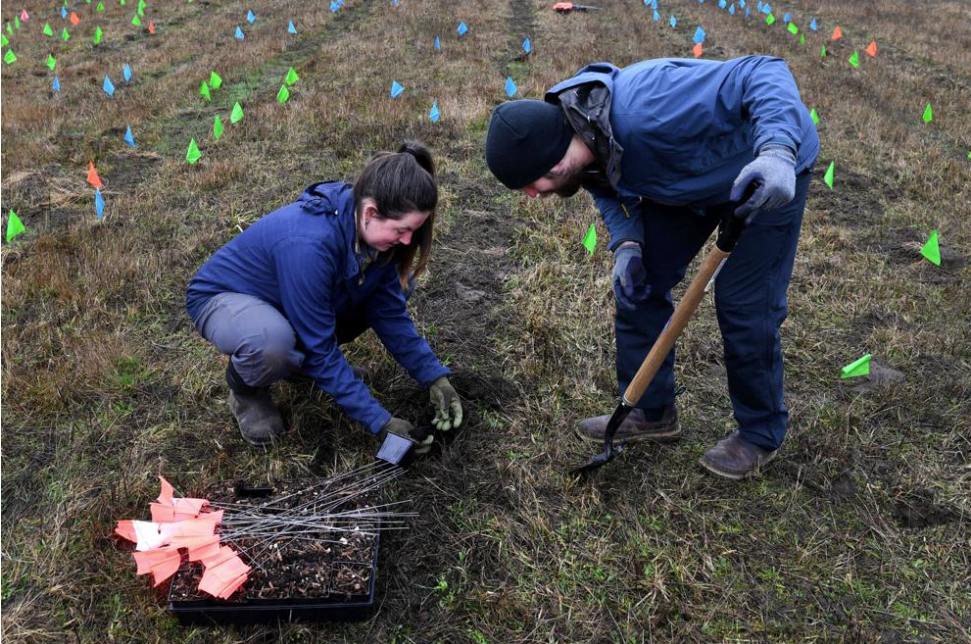TOLEDO — In a muddy field northwest of Toledo, multicolored flags marked the thousands of spots where natural color will push through this spring, signaling the return of one of the most significant plants to the Cowlitz Indian Tribe.
On Friday, about 30 Cowlitz tribal members, staff and volunteers planted thousands of camas bulbs on a tribal property as part of an effort to restore historic landscapes and traditional foods.
“I think it’s very special and very sacred,” said Billie Coon, tribal member. “Isn’t that great to see so many flags?”
The tribe’s Wellness and Diabetes Program and the Natural Resources Department put together the planting event, the second this season. Between Friday and the Dec. 4 event, participants planted 4,000 camas bulbs total.
Camas, a blue-purple flowered member of the lily family with edible bulb-like roots, is one of the most important cultural foods to Northwest Native people, according to information compiled by GRuB, a nonprofit food education program.
The Natural Resources Department got most of the bulbs — half common camas, half great camas — from Beaverlake Nursery in Beavercreek, Oregon, and some from Watershed Garden Works in Longview, said Shalese Jorgenson, natural resources technician.
After planting a smaller area with bulbs in November 2021, staff developed a plan to split the property into 1-acre sections and plant about 4,000 bulbs in one each year, Jorgenson said. When the bulbs are ready for harvest after a couple years, the sections will be harvested on a rotation, she added.
“We’re hoping to get it to the point where it can sustain itself naturally,” without needing people to plant the bulbs, Jorgenson said.
The 5-acre parcel, fittingly located on Camus Road, is the only tribal property with a camas planting of this scale, Jorgenson said. The land is suited for the plant, which likes wet ground in the winter and dry conditions in the summer, she said.
The tribe purchased the property in 2012 following the 2010 death of monument owner Dominic Gospodor, according to The Daily News archives.
Before settlers arrived, Western Washington included large prairies where camas and other edible and medicinal plants grew, according to a blog post by Elise Krohn, GRuB wild foods and medicines program director. Tribes maintained the prairies by burning, weeding, selectively harvesting and aerating the soil.
Before planting began Friday, tribal member and Youth Program Coordinator Clay Koch gave a blessing and spoke about the traditional importance of camas.
Koch said camas, or qáwm’, is the grandmother of Cowlitz and other Native people in the region.
Learning that made the day even more special for one planting pair, Kindra White and her grandmother, Marilynn Davis.
“I’m grateful to be here with my grandmother, planting grandmother,” White said. “Doing the work, being the culture and learning about it is important because a lot of culture has been lost. Having events like these nowadays is special.”
Davis said she came to the tribe’s location at St. Mary’s in Toledo about 20 years ago to learn her heritage because it was taken away. She’s taught her granddaughter what she’s learned since, White said.
A few yards away, another multigenerational pair, Koch and his 7-year-old son, CJ, worked together to plant bulbs. Koch said he likes teaching youth about the traditional practices because it’s easier for them to understand and accept.
“I love being able to pass this on to my son,” Koch said. “It’s something my uncle showed me as a kid. … The next generation is picking up where the elders left off.”
What is camas?
Camas is a blue-purple flowered member of the lily family with edible bulb-like roots.
The starchy bulbs historically made up a large part of Cowlitz people’s diet and helped regulate blood sugar.
Camas bulbs contain high amounts of inulin, a prebiotic fiber which research has linked to health benefits including helping control diabetes.
The bulbs can be boiled, baked or slow roasted, and the latter makes them sweet.
Food sovereignty
Koch said revitalizing camas is essential to the tribe’s food sovereignty. The U.S. Bureau of Indian Affairs defines the term as the ability of communities to determine the quantity and quality of the food they consume by controlling how their food is produced and distributed.
The starchy camas bulbs historically made up a large part of Cowlitz people’s diet and helped regulate blood sugar, Koch added.
Camas bulbs contain high amounts of inulin, a prebiotic fiber which research has linked to health benefits including improved digestive health and helping control diabetes, according to information from the tribe. They can be boiled, baked or slow roasted, and the latter makes them sweet.
As part of the Cowlitz Tribe’s first food sovereignty assessment, released last fall, a survey found many tribal members were unfamiliar with traditional foods like camas, wapato and nettle. The most common reasons for not eating those foods were lacking knowledge on how to gather and prepare them, as well as lack of access to the food itself.
Plant identification and gathering workshops had the highest interest among tribal members who responded to the survey.
Turnout at Friday was higher than the first year and the December event, said Cindy Callahan, the tribe’s Community Wellness Garden coordinator.
“The turnout is beautiful,” she said. “We were nervous about just having 10 people.”
Some planters participated for the first time Friday, while others had attended the December event, including Hannah Long and fellow Lower Columbia School Gardens staff.
The organization has a partnership with the tribe and is trying to incorporate more native plants in school gardens, Long said.
“We wanted to come share this special moment,” she said. “We’re honored to be welcome as guests.”



